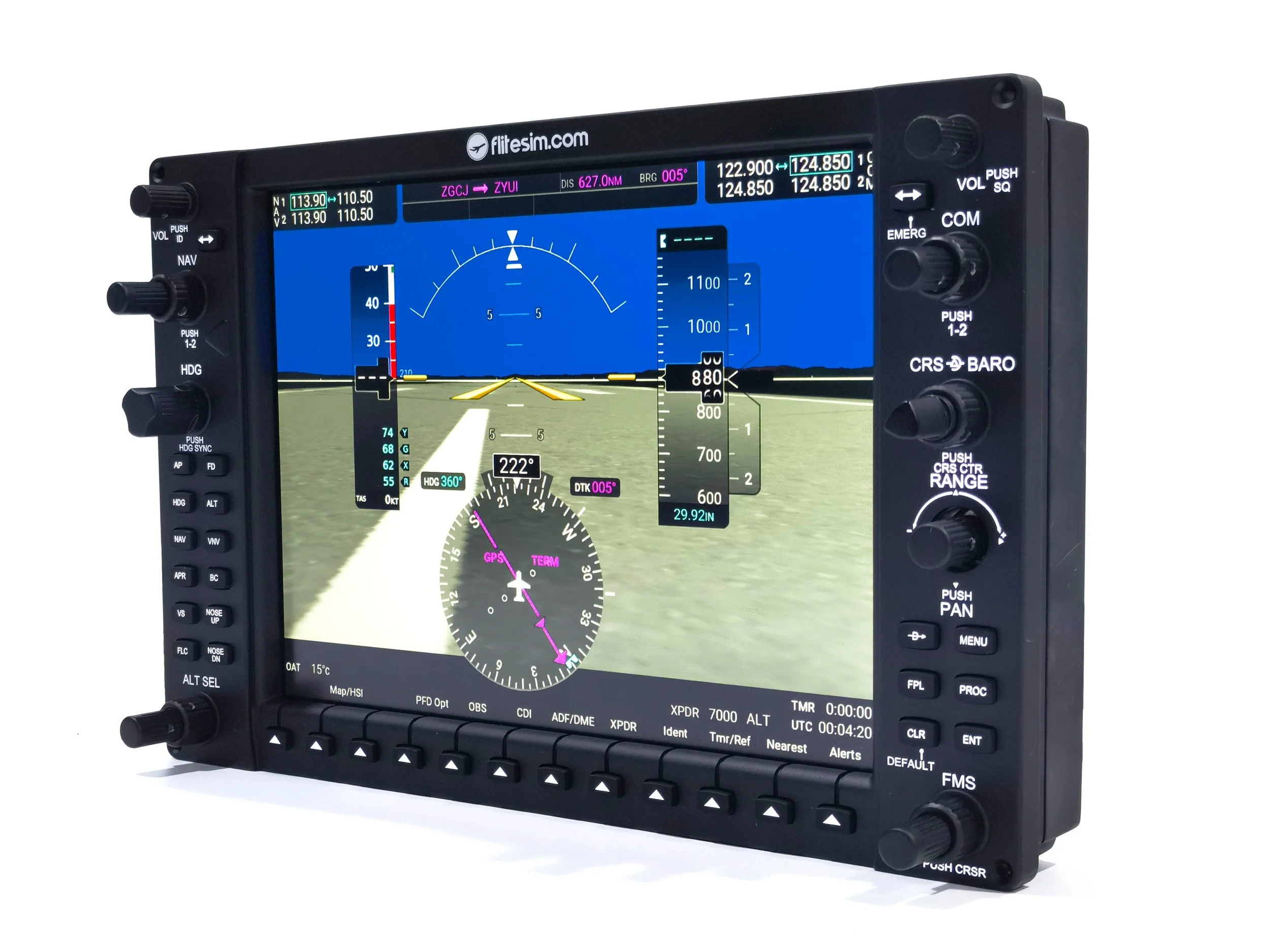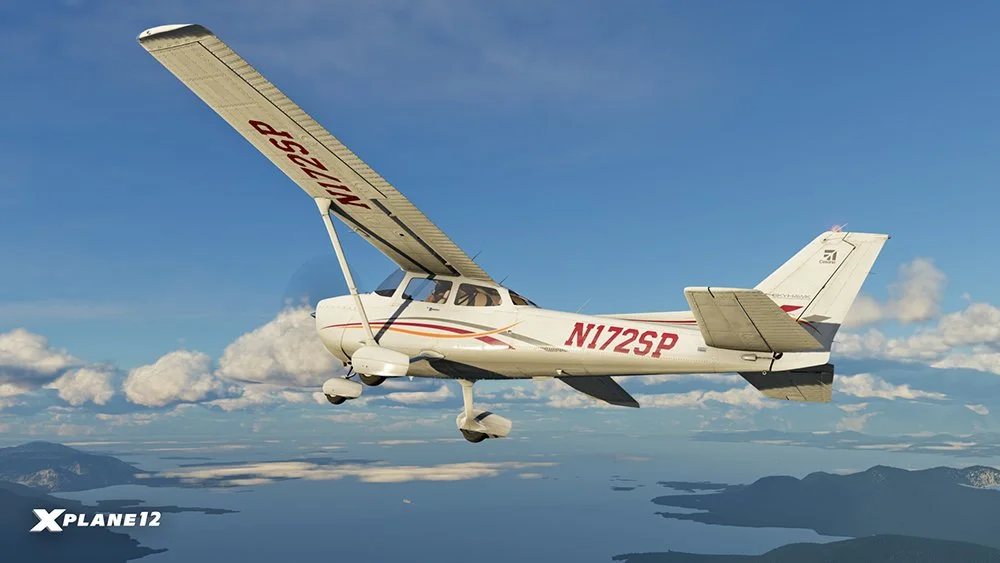
FAA-Approved Basic Aviation Training Device (BATD) Flight Simulator
Disclaimer: FliteSim.com’s Basic Aviation Training Device (BATD) is currently pending official qualification and approval by the Federal Aviation Administration (FAA). The Qualification and Assessment Guide (QAG) has been submitted, and FAA approval is anticipated by end-November 2025.
Effective Professional-Grade Flight Training Starts Here
FliteSim.com is setting a new benchmark for affordable, high-fidelity aviation training devices—engineering its FAA-approved Basic Aviation Training Device (BATD) for flight schools, aviation academies, student and private pilots who demand professional realism without the high cost of full-motion simulators.
Built around our proven CLS-60 Force Feedback Yoke, CLS-Rudder Force Feedback Pedals, FC-50 Flight Console, and integrated G1000 Avionics Suite, the FliteSim BATD delivers a highly realistic, FAA-compliant training experience that faithfully replicates real-aircraft flight dynamics, control response, and cockpit environment.
Force Feedback Control-Loading Technology
At the heart of FliteSim.com’s BATD lies its proprietary Control-Loading System (FFB) — a precision-engineered technology that replicates the true aerodynamic forces acting on an aircraft’s control surfaces. Unlike conventional spring-based simulators, which provide only static resistance, FliteSim’s dynamic force feedback continuously varies control pressure in real time, based on airspeed, trim, aerodynamic load, and flight phase.
This system enables a flight experience that not only feels lifelike but also teaches correct control handling, reinforcing real-world motor skills and procedural accuracy.
Pitch & Roll – Dynamic Aerodynamic Loading:
As airspeed increases, the yoke naturally stiffens, mimicking the aerodynamic resistance felt in actual flight. During stalls or slow flight, the controls lighten — allowing pilots to instinctively sense approaching stall conditions through tactile feedback rather than visual cues alone.
Yaw – Realistic Rudder and Differential Braking Response:
The CLS-Rudder Pedals reproduce authentic yaw control forces, including the variable resistance of the rudder system and the differential friction of the aircraft’s braking mechanism. This enables realistic simulation of coordinated flight, crosswind takeoffs and landings, and side-slip maneuvers — all critical skills for primary and instrument training.
Trim & Autopilot Back-Drive – True Control Synchronization:
When the student applies trim, the system automatically neutralizes control forces; when the autopilot engages, the controls physically move to reflect servo inputs. This ensures perfect synchronization between visual, tactile, and aerodynamic cues, enhancing realism and procedural training integrity.
By faithfully simulating the progressive force gradients and feedback cues of a real aircraft, the FliteSim control-loading system transforms simulation into a genuine learning environment — where students don’t just see how the aircraft flies, but feel it. This tactile realism builds muscle memory, improves control precision, and accelerates the transition from simulator to real-world flight.
Built Around the FC-50 Flight Console (Single-Engine Configuration)
The FC-50 Flight Console forms the core of the FliteSim.com FAA-Approved Basic Aviation Training Device (BATD).
Designed specifically for single-engine aircraft operations, it accurately replicates the ergonomics, control layout, and tactile response of a real Cessna 172 SP or Piper Archer cockpit.
Key Features:
Realistic Cessna-style or Piper-style throttle and mixture controls for authentic single-engine power management.
Motorized elevator trim and motorized flaps position indicator that move in real time with simulator input for enhanced procedural realism.
Full-metal switch panels with magneto, fuel pump, lighting, and avionics master switches.
Functional circuit breakers, Hobbs meter, and a Simulator Freeze button for precise training control and scenario management.
Authentic tactile feedback mirroring real-aircraft ergonomics to reinforce correct procedural flow and muscle memory.
Integrated G1000 Avionics Suite
The FliteSim BATD comes equipped with a fully integrated G1000 Avionics Suite, designed to replicate the glass cockpit environment found in modern training and touring aircraft such as the Cessna 172 SP and Piper Archer.
This advanced flight deck simulation provides pilots and students with a complete Primary Flight Display (PFD), Multi-Function Display (MFD) and Audio interface that responds dynamically to flight data and control inputs — identical in operation to real-world G1000 systems.
Key Capabilities:
Full PFD & MFD Functionality — featuring real-time flight instrumentation, navigation, engine monitoring, and map display.
Audio Control with Integrated GMA Panel — manage and monitor COM/NAV radio channels with soft-touch buttons and LED indicators for true-to-life ATC communication and dual-radio operations.
Dual-Screen Layout — accurately positioned to simulate real cockpit ergonomics and enhance procedural immersion.
Integrated Flight Management System (FMS) — allows flight plan creation, waypoint editing, and GPS navigation training.
Autopilot & Flight Director Simulation — complete with lateral and vertical modes for enroute, approach, and missed-approach procedures.
Engine & Systems Pages — display engine performance, fuel flow, and electrical systems data for realistic power management.
Instrument Approach Practice — train with RNAV, VOR, and ILS procedures using full HSI and CDI guidance within the simulated avionics environment.
The inclusion of a G1000-based glass cockpit prepares students for the transition to modern general aviation aircraft, helping them develop familiarity with integrated avionics workflows, situational awareness, and IFR proficiency — all within the safety and convenience of a ground-based simulator.
Approved Aircraft Flight Models
FliteSim.com has submitted its Qualification and Assessment Guide (QAG) to the Federal Aviation Administration (FAA) for two aircraft-type flight models:
Cessna 172 SP (G1000)
Piper Archer (G1000)
Each flight model has been meticulously engineered to replicate real-world flight characteristics, control dynamics, and avionics behavior in accordance with FAA Advisory Circular 61-136B. The QAG outlines the device’s hardware, software, flight controls, and flight model validation data to ensure each simulated aircraft meets the required fidelity standards for FAA qualification.
These two aircraft configurations were specifically chosen to provide comprehensive training coverage — from the Cessna 172 SP’s high-wing stability ideal for primary training, to the Piper Archer’s low-wing handling dynamics favored for advanced and instrument instruction.
Together, they form the foundation of the FliteSim BATD, offering students and instructors a realistic, FAA-compliant training experience across both aircraft platforms.
Once fully qualified under FAA Advisory Circular 61-136B, the FliteSim BATD will allow pilots to log creditable flight time toward:
Private Pilot License (PPL) – up to 2.5 hours
Instrument Rating (IR) – up to 10 hours

FliteSim.com FAA-Approved BATD
Innovations Beyond Traditional FAA-Approved BATDs
FliteSim.com’s control-loading ecosystem goes far beyond conventional FAA-approved BATD flight simulator setups…
Introducing two industry-first innovations that redefine what’s possible in desktop-based flight training.
Remote Sync — Shared Cockpit, Without Borders
For the first time, pilots and instructors across the world can now experience true shared cockpit control loading — thanks to FliteSim.com’s Remote Sync technology.
This feature unlocks unprecedented opportunities:
Remote Flight Instruction: Instructors can physically feel their student’s control handling from anywhere in the world.
Shared Cockpit Training: Two pilots can fly the same virtual aircraft together, each with synchronized tactile feedback.
Community Engagement: Simulator enthusiasts can collaborate, instruct, or co-pilot online with a realism never before possible.
Replay Sync — Relive the Flight, Physically
FliteSim.com also introduces another industry first — enabling its CLS-60 Force Feedback Yoke and CLS-Rudder Pedals to mirror control inputs during X-Plane Replay mode.
This transforms replay into a powerful training tool:
Flight Analysis with Feel: Re-experience every flare, stall, or crosswind correction exactly as it was flown.
Error Diagnosis: Instructors and students can physically sense what went wrong during a maneuver, not just see it.
Enhanced Immersion: Relive your best flights with the full tactile sensation of being in the cockpit again.
Together, Remote Sync and Replay Sync extend the boundaries of traditional simulator realism — turning FliteSim’s BATD into both a training and collaboration platform.

FAA-Approved Flight Training
— More Efficient, More Affordable, Fully Creditable
FAA-Approved Flight Training Credit
Train Smarter. Fly Sooner. Save More.
Once fully qualified under FAA Advisory Circular 61-136B, the FliteSim BATD (Basic Aviation Training Device) will allow pilots to log officially creditable simulator time toward both Private Pilot and Instrument Rating certifications under 14 CFR Part 61.
Earn Credit Toward Your Private Pilot License (PPL)
Build confidence, save fuel, and arrive at your first flight lesson fully prepared.
Under 14 CFR §61.109(k)(1), you can log up to 2.5 hours of approved simulator time toward your Private Pilot license.
Practice essential maneuvers, cockpit procedures, and emergency drills — all in a safe, cost-effective training environment before stepping into a real aircraft.
Log 10 Hours Toward Your Instrument Rating (IR)
Master IFR procedures from the comfort of your training center — at a fraction of the cost.
Under 14 CFR §61.65(i) and AC 61-136B Appendix 2, you can credit up to 10 hours of BATD time toward your Instrument Rating requirements.
Train in realistic IFR scenarios: instrument scanning, holds, approaches, and partial-panel operations — all using our high-fidelity G1000 avionics suite.
Stay Instrument-Current — Without Leaving the Ground
Maintain proficiency and log official instrument experience from the ground.
According to §61.57(c)(1–5), instrument-rated pilots must complete within the last 6 months:
6 instrument approaches
Holding procedures
Course intercepting and tracking
All of this can be done in the FliteSim BATD under simulated instrument conditions with a view-limiting device. Each session is fully loggable — including date, total time, and type of approach — in compliance with FAA regulations.
Regain Currency with an IPC in the BATD
Keep your instrument flying skills sharp and your currency current — quickly and affordably.
If your instrument currency lapses beyond 6 months, you can requalify by performing the required tasks with an instructor in an approved BATD.
After 12 months, you’ll need an Instrument Proficiency Check (IPC) under §61.57(d) — which can also be conducted in the FliteSim BATD if authorized.
The IPC covers approaches, holds, tracking, and unusual-attitude recovery to Instrument Rating ACS standards.
Why Flight Schools Love the FliteSim BATD
It’s not just a desktop flight simulator — it’s an FAA-approved training platform that delivers results.
FAA-Recognized for PPL, IR, and Instrument Currency
Reduces aircraft rental costs by up to 30–50%
Increases instructor flexibility and student throughput
Enhances student readiness for real-world flight training
References
FAA Advisory Circular 61-136B – Aviation Training Devices: Qualification, Approval, and Use
14 CFR §61.109(k)(1) – Aeronautical Experience, Private Pilot
14 CFR §61.65(i) – Aeronautical Experience, Instrument Rating
14 CFR §61.57(c)(1–5), (d) – Recent Flight Experience: Instrument

“It all begins with an idea. Maybe you want to launch a business. Maybe you want to turn a hobby into something more. Or maybe you have a creative project to share with the world. Whatever it is, the way you tell your story online can make all the difference.”
— Squarespace









